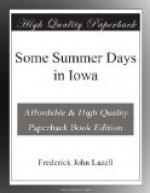Springing from a log lying by the fence a dozen plants of the glistening coprinus have reared themselves since morning, fresh from the rain and flavored as sweet as a nut. Narrow furrows and sharp ridges adorn their drooping caps; these in turn are decorated with tiny shining scales. Nibbling at the nut-like flesh, I am touched with the nicety, the universality of nature’s appeal to the finer senses and sentiments. Here is form and color and sparkle to please the eye, flesh tender to the touch, aroma that tests the subtlest sense of smell, taste that recalls stories of Epicurean feasts, millions of life-germs among the purple-black gills, ready to float in the streams of the atmosphere to distant realms and other cycles of life. No dead log and toadstools are here, but dainty shapes with billions of possibilities for new life, new beauties, new thoughts.
* * * * *
[Illustration: Young blue-jay trying to climb back to its nest
“The wood thrush has A late nest in A young elm” (p. 41)
“The chipmunk holds in his paws A bit of bread” (p. 20)]
Goldfinches ride on the billows of the air, now folding their pinions and shooting silently downward into the trough of the sea, then opening their wings and beating their way upwards, singing meanwhile. Going over the woods they fly twenty to thirty feet above the tops of the tallest trees, but when they reach the meadow lands they drop to about the same height above the surface of the ground. Only a few of them are nesting yet. The tall thistle by the roadside is nearly ten feet high, but its heads have not fully opened. They like its down for their nests and its seeds to feed the fledgelings. They fly in pairs often and in the evenings they cling prettily to the catnip by the pasture fence, digging into each calyx for its four sweet nutlets. The woodthrush has a late nest in a young elm; her first family was eaten by the blue-jays just after the hatching,—so were the young grosbeaks in a nearby tree, but the cedar waxwings were slain and eaten by the cannibalistic grackles. A blue-jay is just approaching the wood pewee’s nest in the burr oak, but the doughty husband does battle with the fierceness of a kingbird and chases him away. Three tiny birdlings, covered with hairs soft and white as the down of a thistle, are in the nest, which is saddled snugly to the fork of a horizontal tree. In another nest, near by, the three eggs have only just been laid. The path which used to run under the over-hanging trees is grown up with grasses. Here the slender rush grows best, and makes a dark crease among the taller and lighter-green grasses, showing where the path winds. Twenty feet overhead, on the slender branch of a white oak, is a tiny knot, looking scarcely larger




